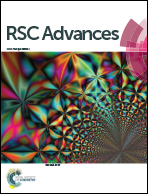Preparation and application of amorphous Fe–Ti bimetal oxides for arsenic removal†
Abstract
A series of Fe–Ti bimetal oxides for As(III) and As(V) removal were synthesized through a co-precipitation method. Various techniques including BET surface area measurement, XRD, SEM and TEM were used to characterize the synthesized Fe–Ti bimetal oxides. Comparison results indicated that the bimetal oxide with a Fe : Ti molar ratio of 0.8 : 0.2 showed the best performance in As(III) removal, and the maximal adsorption capacity of As(III) and As(V) were 111.37 mg g−1 and 31.42 mg g−1 at pH 7, respectively. The two-compartment first-order model has been proven more appropriate than other models for fitting As(III) and As(V) adsorption kinetics. Two domains (i.e., fast and slow compartments) controlled the adsorption of arsenic at different contact times. The adsorption isotherms of As(III) and As(V) could be well described by the Freundlich and Langmuir models. The maximum adsorption amount of As(III) occurred at pH 9.2, and adsorption amount of As(V) decreased with increasing pH of solution. The ionic strength showed little effect on As(III) adsorption, while the adsorption amount of As(V) tended to increase with increasing ionic strength, indicating that As(III) and As(V) adsorption are specific adsorption. The coexisting sulfate and bicarbonate had little effect on arsenic removal, however the presence of phosphate inhibited arsenic removal significantly. The synthesized bimetal oxide was chemically stable throughout pH 4–9 and reusable.


 Please wait while we load your content...
Please wait while we load your content...